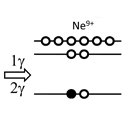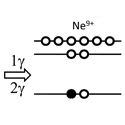A double whammy of x rays
Photons can pair up to ionize an atom when individually they’re not energetic enough to do the job. However, this requires an intense light source so that the atom can absorb two photons in rapid succession. Using the world’s most powerful x-ray laser, scientists have for the first time observed two-photon absorption in the x ray part of the spectrum. In the experiment, which is presented in Physical Review Letters, x rays from the Linac Coherent Light Source (LCLS) stripped the innermost electrons of a neon atom at a rate over times higher than predicted by theoretical models.
For fifty years now, physicists have been exploring two-photon absorption at energies corresponding to infrared, visible, and ultraviolet wavelengths. The technique has been used to study electronic properties of atoms and molecules, to image human tissues, and to improve the resolution for photolithography. Despite scientific interest in expanding this nonlinear optical effect to higher energies, x-ray sources with adequate intensity have been lacking until now.
Completed in 2009, the LCLS at the SLAC National Accelerator Laboratory produces ultrashort pulses of trillion x-ray photons. In their experiments, Gilles Doumy, of The Ohio State University, and his colleagues placed a neon target in the beam path and tuned the energy of the x rays to just above and just below the energy threshold ( ) for ionizing electrons in the shell of neon. By analyzing the ions that emerged from the target, the team found evidence of two-photon absorption. The authors expect their results will be an important step towards probing the interiors of solid samples with x rays. – Michael Schirber





